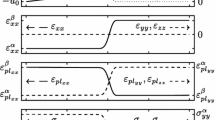Abstract
A two-phase elasto-plastic material is investigated. It is shown that, if the interface is modeled as the limit of a vanishing layer of a third material, then the resulting two-phase material will exhibit a smaller interfacial dissipation than that of a pure two-phase model.
Similar content being viewed by others
References
Ambrosio, L., Coscia, A. and Dal Maso, G., Fine properties of functions with bounded deformations, Arch. Rat. Mech. Anal., 139, 1997, 201–238.
Ambrosio, L., Fusco, N. and Pallara, D., Functions of Bounded Variation and Free Discontinuity Problems, Oxford University Press, Oxford, 2000.
Dal Maso, G., DeSimone, A. and Mora, M. G., Quasistatic evolution problems for linearly elastic-perfectly plastic materials, Arch. Ration. Mech. Anal., 180(2), 2006, 237–291.
Evans, L. C. and Gariepy, R. F., Measure theory and fine properties of functions, CRC Press, Boca Raton, FL, 1992.
Francfort, G. A. and Giacomini, A., Small-strain heterogeneous elastoplasticity revisited, Comm. Pure Appl. Math., 65(9), 2012, 1185–1241.
Kohn, R. V. and Temam, R., Dual spaces of stresses and strains, with applications to Hencky plasticity, Appl. Math. Optim., 10(1), 1983, 1–35.
Mainik, A. and Mielke, A., Existence results for energetic models for rate-independent systems, Calc. Var. Partial Differential Equations, Evolution of rate-independent systems, Evolutionary Equations. Vol. II, Handb. Differ. Equ., Dafermos, A. and Feireisl, E. (eds.), Elsevier, North-Holland, Amsterdam, 2005, 461–559.
Solombrino, F., Quasistatic evolution problems for nonhomogeneous elastic plastic materials, J. Convex Anal., 16(1), 1979, 89–119.
Suquet, P. M., Un espace fonctionnel pour les équations de la plasticité, Ann. Fac. Sci. Toulouse Math. (5), 1(1), 1979, 77–87.
Suquet, P. M., Sur les équations de la plasticité: existence et régularité des solutions, J. Mécanique, 20(1), 1981, 3–39.
Temam, R., Problèmes mathématiques en plasticité, Méthodes Mathématiques de l’Informatique [Mathematical Methods of Information Science], Vol. 12, Gauthier-Villars, Montrouge, 1983.
Author information
Authors and Affiliations
Corresponding author
Additional information
Dedicated to Luc Tartar Notwithstanding His Dislike for Elasto-Plasticity
Rights and permissions
About this article
Cite this article
Francfort, G.A., Giacomini, A. The role of a vanishing interfacial layer in perfect elasto-plasticity. Chin. Ann. Math. Ser. B 36, 813–828 (2015). https://doi.org/10.1007/s11401-015-0978-5
Received:
Published:
Issue Date:
DOI: https://doi.org/10.1007/s11401-015-0978-5



